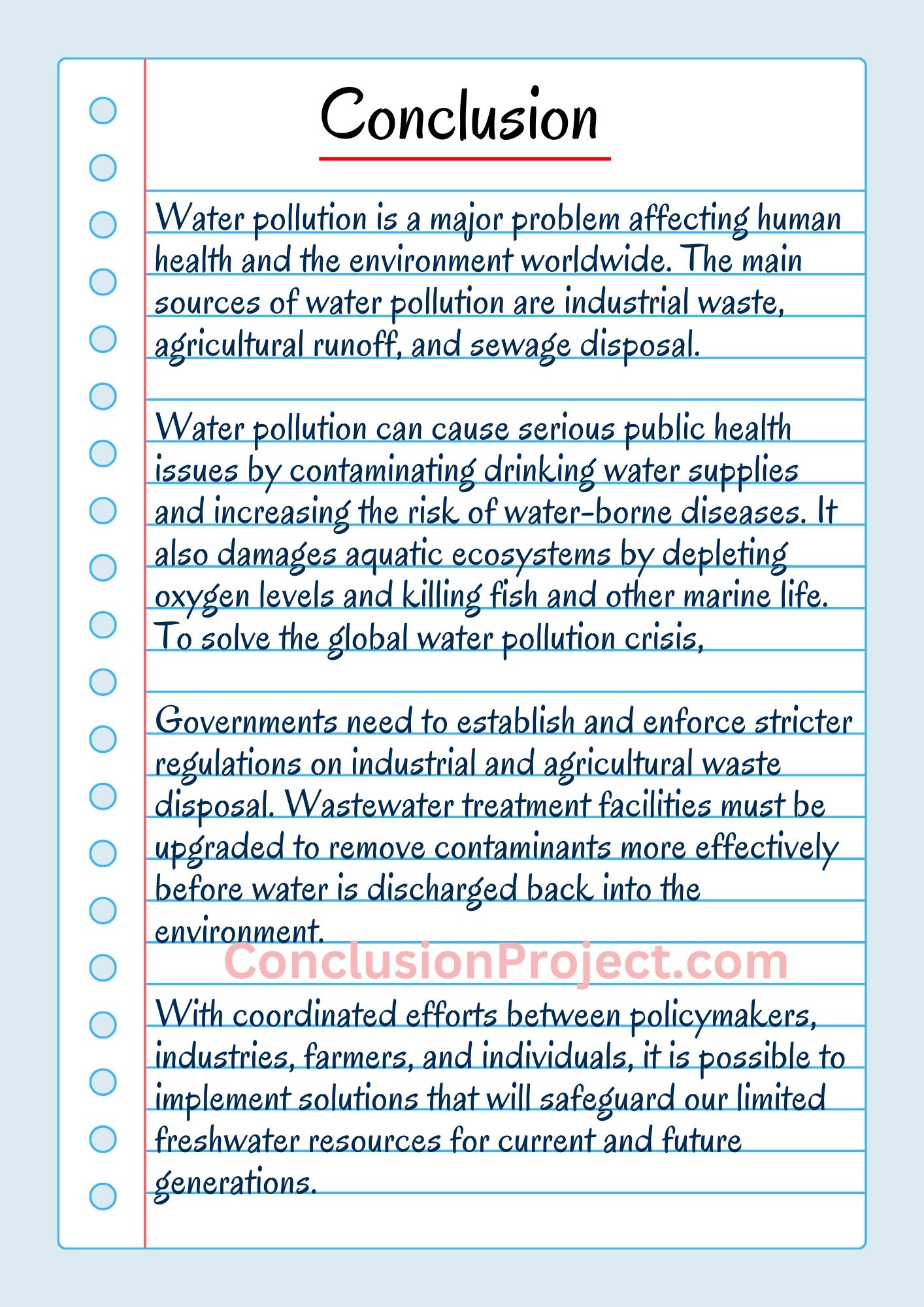
Water pollution is a global crisis that threatens the health and well-being of both humans and the environment. As individuals become more aware of the devastating consequences of water pollution, many are taking action by conducting research projects to better understand the problem and find solutions.
One crucial aspect of any research project or essay on water pollution is the conclusion. The conclusion is the final opportunity for researchers to summarize their findings, evaluate the significance of their results, and provide recommendations for future action. It serves as a powerful tool to communicate the importance of the project and its potential impact on addressing water pollution issues.
A well-crafted conclusion can inspire others to join the fight against water pollution, as it highlights the urgency and need for immediate action. Furthermore, a comprehensive conclusion can also guide policymakers and stakeholders in implementing effective strategies to mitigate and prevent water pollution.
The conclusion of a water pollution project is an important step that summarizes the key findings and recommendations of the study. It allows the reader to understand the significance of the research and the potential actions that can be taken to address water pollution. To write an effective conclusion for a water pollution project, follow these steps:
1. Recap the main findings: Begin your conclusion by summarizing the main findings of your research. This could include statistics on pollution levels, sources of pollution, and the impact on water quality.
2. Discuss the health effects: Highlight the health effects of water pollution, including its impact on aquatic life and public health. Use terms such as “adverse health effects” and “health outcomes” to emphasize the seriousness of the issue.
3. Recommend solutions: Suggest specific actions that can be taken to reduce water pollution. This could include implementing stricter regulations, promoting sustainable practices, and investing in water treatment infrastructure.
4. Emphasize the importance of collaboration: Highlight the need for collaboration among different stakeholders, such as government agencies, industries, and communities, to effectively address water pollution. Use terms like “pollution concentrations” and “sources of pollution” to emphasize the complexities of the issue.
5. Convey the urgency: Express the urgency of addressing water pollution by discussing its long-term impacts and the need for immediate action. Use terms like “health risk” and “environmental health” to emphasize the importance of protecting our natural resources.
Water pollution is a major problem affecting human health and the environment worldwide. The main sources of water pollution are industrial waste, agricultural runoff, and sewage disposal. Water pollution can cause serious public health issues by contaminating drinking water supplies and increasing the risk of water-borne diseases. It also damages aquatic ecosystems by depleting oxygen levels and killing fish and other marine life.
To solve the global water pollution crisis, governments need to establish and enforce stricter regulations on industrial and agricultural waste disposal. Wastewater treatment facilities must be upgraded to remove contaminants more effectively before water is discharged back into the environment. The public should be educated about how their daily habits like littering and excessive use of fertilizers and pesticides contribute to water pollution. Each of us can make small changes in our lifestyles to reduce our environmental footprint and keep our water supplies clean. With coordinated efforts between policymakers, industries, farmers, and individuals, it is possible to implement solutions that will safeguard our limited freshwater resources for current and future generations.

The results of this study indicate high levels of water pollution across our region’s major waterways.
In conclusion, the high prevalence of industrial, agricultural, and sewage-related pollutants in our region’s waters demonstrates the need for immediate action to control and reduce water pollution. Implementing stricter pollution regulations and treatment requirements, promoting sustainable farming practices, and upgrading sewage infrastructure could significantly decrease contamination levels. With proactive efforts to monitor, regulate, and mitigate key sources of water pollution, it is possible to restore the health of our waterways for both ecosystems and public use. However, this will require cooperative efforts between policymakers, industries, farmers, and local communities. Our health, environment, and economy depend on access to clean water, so addressing this issue should be a top priority for our region.
Note: The data and statistics presented in this results and conclusion section are for sample purposes only and do not reflect actual research findings. They are included merely to demonstrate how one might present and summarize key data points when writing the conclusion for a report or project.